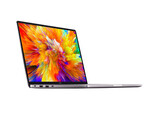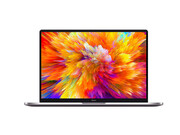Xiaomi RedmiBook Pro 15, i5-11320H iGPU
Ausstattung / Datenblatt

Preisvergleich
Testberichte für das Xiaomi RedmiBook Pro 15, i5-11320H iGPU
Quelle: Cashify
 EN→DE Archive.org version
EN→DE Archive.org versionMy overall experience with the RedmiBook Pro is a bit of a mixed bag. While I really liked the solid zero-stutter performance of the laptop, a couple of other things genuinely were a bit of a no-no. If you are okay with a very average display that is not one-bit colour accurate or punchy, you can go ahead with it. Sadly, it doesn’t end there. It just does not seem worth it for the price you will be paying for the laptop. Would it be worth it had it been priced at, say, around Rs. 40,000 to Rs. 45,000? TOTALLY. It would have been an absolute value-for-money laptop to go for. This would have been the right kind of pricing to back up the Redmi branding as we know it. The integrated chipset would have made sense as well. However, if the Mi Notebook is offering you a dedicated GPU at a lower price, why would you choose the RedmiBook Pro over it anyway? It all comes down to perspective and how you will not mind the average display and pricing of the laptop. Keeping these things in mind, I hope your questions have been answered.
Einzeltest, online verfügbar, Lang, Datum: 31.03.2022
Quelle: Igeekphone
 EN→DE Archive.org version
EN→DE Archive.org versionThe RedmiBook Pro 15 enhanced version uses what may be the best screen that can be used in a thin and light book with a price of 5,000 yuan. It has a resolution of 3200*2000, a 100% sRGB color gamut, a static contrast ratio of 1500:1, and a 90Hz refresh rate. As for the internal workmanship, after dismantling the enhanced version of RedmiBook Pro 15, it can be seen that its internal layout is very neat, no flying wires can be seen, and important components are protected by metal shields. The last is the price. The original price of the RedmiBook Pro 15 enhanced version (i5-11320H) is 5299 yuan, and now you can get this machine within 5000 yuan in many promotions. It is difficult to find a notebook with a higher cost performance than it at the price of less than 5,000 yuan on the market.
Einzeltest, online verfügbar, Lang, Datum: 07.01.2022
Kommentar
Intel Iris Xe G7 96EUs: Integrierte Grafikkarte (in Tiger-Lake G7 SoCs) der Gen. 12 Architektur mit 96 EUs.
Diese Klasse ist noch durchaus fähig neueste Spiele flüssig darzustellen, nur nicht mehr mit allen Details und in hohen Auflösungen. Besonders anspruchsvolle Spiele laufen nur in minimalen Detailstufen, wodurch die grafische Qualität oft deutlich leidet. Diese Klasse ist nur noch für Gelegenheitsspieler empfehlenswert. Der Stromverbrauch von modernen Grafikkarten in dieser Klasse ist dafür geringer und erlaubt auch bessere Akkulaufzeiten.
» Weitere Informationen gibt es in unserem Notebook-Grafikkartenvergleich und der Benchmarkliste.
i5-11320H: Auf der Tiger-Lake-Architektur basierender SoC (System-on-a-Chip) für schlanke Gaming-Notebooks und Workstations. Integriert unter anderem vier CPU-Kerne mit 2.5 - 3,2 Basistakt (28 - 35W TDP) und 4,5 GHz Boost, HyperThreading sowie eine starke G7 Grafikeinheit und wird in 10-Nanometer-Technik gefertigt (10nm SuperFin). » Weitere Infos gibt es in unserem Prozessorvergleich Vergleich mobiler Prozessoren und der Prozessoren Benchmarkliste .


